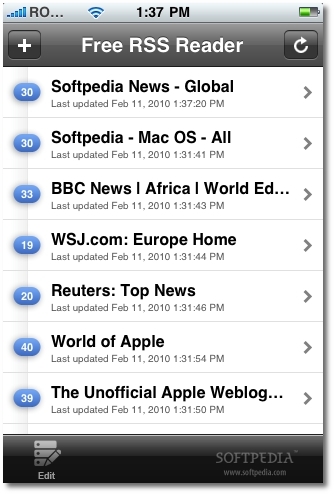

Next time you run nom and hit r to refresh it’ll pull in the latest content from added feeds. It is also installable via go, the details of which can be found on the nom GitHub project page.
Opml rss reader download#
You can download nom from GitHub as a standalone binary app for Windows, macOS, and Linux.

The no-frills approach won’t suit some but the lack of features mean nom is blazing fast, intuitive commands, and a UI that’s beautiful to look at. Other CLI RSS apps do a lot but nom tries to do as little as possible.

Which is to say: simplicity is the selling point here. Nom is a no-frills RSS feed reader for the terminal that’s perfect for casual users not needing advanced features, cloud service integrations, keep tabs on they’ve read and what they haven’t, and similar. Yet despite that, it still manages to be accessible for new users with less demanding needs. In short, Newsboat is the most powerful, configurable command line RSS reader out there. you can configure Newsboat to sync with cloud-based RSS readers like Tiny Tiny RSS, Nextcloud, and The Old Reader. Now, when you run newsboat in a terminal emulator it’ll track the links you added.Īlternatively, you can import an OPML file in Newsboat by running newsboat -i /path/to/feeds.opml. Create a ~/.newsboat/urls file (by hand, in any text editor), and add the RSS feed addresses for the sites you want to track inside of it, and hit save.
Opml rss reader install#
To install Newsboat on Ubuntu, Fedora, and other major Linux distributions check your distro’s archive for package name newsboat (you should find it easily as it’s widely available).
Opml rss reader plus#
Plenty of advanced features are available, including feed parsing (so you only see content you explicitly care about) customizable color schemes and the ability to run external commands on feed items - plus a LOT more. Since some content makes more sense in a regular browser you can instantly open any article you’re reading in Firefox (or another default) by pressing o whilst viewing the article in question. Once you’ve added feeds (we’ll get to that in a sec) you can run newsboat, press R to pull-in the latest posts, then scroll through them using arrow keys, hit enter to open a feed, select an article using arrow keys, and enter again to load it for reading. It helps that the Newsboat interface is very easy to navigate, even for those less familiar with ‘terminal user interface.’ At its simplest, Newsboat gathers together the latest posts from your favorite sources so you can browse and read them right there, in the terminal. When it comes to command line RSS readers Newsboat is the most well known, popular, and commonly recommended app in its class. Still, terminal-based tools are not for everyone, and some people find them more difficult to use than a traditional GUI tool.īut if you never try, you never know… Newsboat Terminal-based RSS readers offer speed and efficiency (plus fewer distractions from embedded images, videos, etc) greater privacy (no cloud-based service logging what you read) and have much lower resource usage (text-based tools tend to be more nimble). You can also use a command line RSS reader, like the ones featured below. This includes desktop clients like NewsFlash, Liferea, and RSSOwl, through to side-features in other apps, like Thunderbird and Vivaldi (that browser does everything but your laundry).

Instead of you needing to open 10 different websites in your browser each morning, you open your RSS reader and see it all there, saving you time and effort.Ī wide range of RSS reader apps (often called a news aggregator) for Linux are available. When combined with an RSS reader, the “Really Simple Syndication” format does the hard work of fetching news for you. RSS feeds remain one of the best ways to keep a (non-algorithmically-adjusted) eye on the latest content from your favourite websites, blogs, projects, and more.


 0 kommentar(er)
0 kommentar(er)
